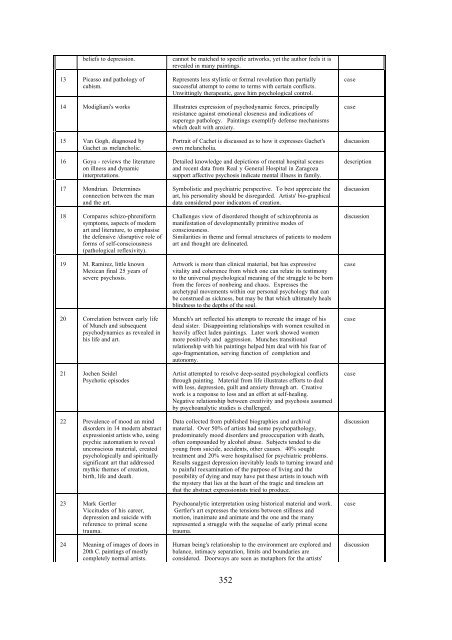The psychopathology of everyday art: a quantitative Study - World ...
The psychopathology of everyday art: a quantitative Study - World ...
The psychopathology of everyday art: a quantitative Study - World ...
Create successful ePaper yourself
Turn your PDF publications into a flip-book with our unique Google optimized e-Paper software.
eliefs to depression. cannot be matched to specific <strong>art</strong>works, yet the author feels it is<br />
revealed in many paintings.<br />
13 Picasso and pathology <strong>of</strong><br />
cubism.<br />
Represents less stylistic or formal revolution than p<strong>art</strong>ially<br />
successful attempt to come to terms with certain conflicts.<br />
Unwittingly therapeutic, gave him psychological control.<br />
14 Modigliani's works Illustrates expression <strong>of</strong> psychodynamic forces, principally<br />
resistance against emotional closeness and indications <strong>of</strong><br />
superego pathology. Paintings exemplify defense mechanisms<br />
which dealt with anxiety.<br />
15 Van Gogh, diagnosed by<br />
Gachet as melancholic.<br />
16 Goya - reviews the literature<br />
on illness and dynamic<br />
interpretations.<br />
17 Mondrian. Determines<br />
connection between the man<br />
and the <strong>art</strong>.<br />
18 Compares schizo-phreniform<br />
symptoms, aspects <strong>of</strong> modern<br />
<strong>art</strong> and literature, to emphasise<br />
the defensive /disruptive role <strong>of</strong><br />
forms <strong>of</strong> self-consciousness<br />
(pathological reflexivity).<br />
19 M. Ramirez, little known<br />
Mexican final 25 years <strong>of</strong><br />
severe psychosis.<br />
20 Correlation between early life<br />
<strong>of</strong> Munch and subsequent<br />
psychodynamics as revealed in<br />
his life and <strong>art</strong>.<br />
21 Jochen Seidel<br />
Psychotic episodes<br />
22 Prevalence <strong>of</strong> mood an mind<br />
disorders in 14 modern abstract<br />
expressionist <strong>art</strong>ists who, using<br />
psychic automatism to reveal<br />
unconscious material, created<br />
psychologically and spiritually<br />
significant <strong>art</strong> that addressed<br />
mythic themes <strong>of</strong> creation,<br />
birth, life and death.<br />
23 Mark Gertler<br />
Viccitudes <strong>of</strong> his career,<br />
depression and suicide with<br />
reference to primal scene<br />
trauma.<br />
24 Meaning <strong>of</strong> images <strong>of</strong> doors in<br />
20th C. paintings <strong>of</strong> mostly<br />
completely normal <strong>art</strong>ists.<br />
Portrait <strong>of</strong> Cachet is discussed as to how it expresses Gachet's<br />
own melancholia.<br />
Detailed knowledge and depictions <strong>of</strong> mental hospital scenes<br />
and recent data from Real y General Hospital in Zaragoza<br />
support affective psychosis indicate mental illness in family.<br />
Symbolistic and psychiatric perspective. To best appreciate the<br />
<strong>art</strong>, his personality should be disregarded. Artists' bio-graphical<br />
data considered poor indicators <strong>of</strong> creation.<br />
Challenges view <strong>of</strong> disordered thought <strong>of</strong> schizophrenia as<br />
manifestation <strong>of</strong> developmentally primitive modes <strong>of</strong><br />
consciousness.<br />
Similarities in theme and formal structures <strong>of</strong> patients to modern<br />
<strong>art</strong> and thought are delineated.<br />
Artwork is more than clinical material, but has expressive<br />
vitality and coherence from which one can relate its testimony<br />
to the universal psychological meaning <strong>of</strong> the struggle to be born<br />
from the forces <strong>of</strong> nonbeing and chaos. Expresses the<br />
archetypal movements within our personal psychology that can<br />
be construed as sickness, but may be that which ultimately heals<br />
blindness to the depths <strong>of</strong> the soul.<br />
Munch's <strong>art</strong> reflected his attempts to recreate the image <strong>of</strong> his<br />
dead sister. Disappointing relationships with women resulted in<br />
heavily affect laden paintings. Later work showed women<br />
more positively and aggression. Munches transitional<br />
relationship with his paintings helped him deal with his fear <strong>of</strong><br />
ego-fragmentation, serving function <strong>of</strong> completion and<br />
autonomy.<br />
Artist attempted to resolve deep-seated psychological conflicts<br />
through painting. Material from life illustrates efforts to deal<br />
with loss, depression, guilt and anxiety through <strong>art</strong>. Creative<br />
work is a response to loss and an effort at self-healing.<br />
Negative relationship between creativity and psychosis assumed<br />
by psychoanalytic studies is challenged.<br />
Data collected from published biographies and archival<br />
material. Over 50% <strong>of</strong> <strong>art</strong>ists had some <strong>psychopathology</strong>,<br />
predominately mood disorders and preoccupation with death,<br />
<strong>of</strong>ten compounded by alcohol abuse. Subjects tended to die<br />
young from suicide, accidents, other causes. 40% sought<br />
treatment and 20% were hospitalised for psychiatric problems.<br />
Results suggest depression inevitably leads to turning inward and<br />
to painful reexamination <strong>of</strong> the purpose <strong>of</strong> living and the<br />
possibility <strong>of</strong> dying and may have put these <strong>art</strong>ists in touch with<br />
the mystery that lies at the he<strong>art</strong> <strong>of</strong> the tragic and timeless <strong>art</strong><br />
that the abstract expressionists tried to produce.<br />
Psychoanalytic interpretation using historical material and work.<br />
Gertler's <strong>art</strong> expresses the tensions between stillness and<br />
motion, inanimate and animate and the one and the many<br />
represented a struggle with the sequelae <strong>of</strong> early primal scene<br />
trauma.<br />
Human being's relationship to the environment are explored and<br />
balance, intimacy separation, limits and boundaries are<br />
considered. Doorways are seen as metaphors for the <strong>art</strong>ists'<br />
352<br />
case<br />
case<br />
discussion<br />
description<br />
discussion<br />
discussion<br />
case<br />
case<br />
case<br />
discussion<br />
case<br />
discussion

















